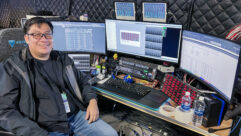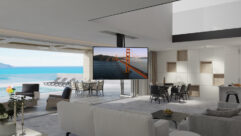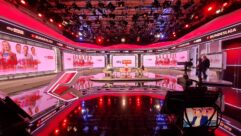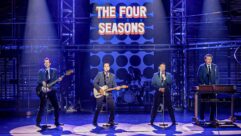
Installation Profile: All Hail the Queen
Sep 1, 2004 12:00 PM,
By Christian Doering
Queens Room ballroom
The numbers are just plain big. After 5 years of planning and 15 months of construction in the shipyard of ALSTOM Chantiers de l’Atlantique at Saint-Nazaire in France, the longest (1,132 feet), tallest (23 stories), widest (137 feet), and heaviest (151,400 gross tons) passenger liner ever built has been completed: theQueen Mary 2,the flagship of Cunard line (which is, in turn, the flagship of Carnival Corp., its corporate parent).
As you might expect from her enormous scale, Cunard’s newest Queen is also the most expensive passenger ship in history: it cost about $800 million to float this particular boat. Luxury features include a 20,000-square-foot Canyon Ranch SpaClub and five duplex penthouse suites, each with living/dining room area, minigym, private library, and private butler service (keep those in mind in case you should find yourself with a week and $45,000 to spend traveling between New York and Southampton, England). Two forward suites, by the way, are accessible through glass-walled elevators that rise along both sides of the superstructure. Christened in Southampton by Queen Elizabeth II on January 8, 2004, the Queen Mary 2 made her maiden Atlantic crossing to Fort Lauderdale, Florida. From there she departed for Rio de Janeiro and Carnaval. On her return, she crossed the Atlantic during the spring and summer, and she’ll be visiting Canada and New England as the fall leaves turn. But no matter where it makes port, this ship is intended to be a destination in and of itself.

The G32 nightclub with displays.
THE BIG PICTURE
The AV systems on board are equally impressive: the equipment list alone runs 35 pages. Between the many public venues, as well as passenger cabins for 2,620 and staff berths for about half that number — not to mention a network-quality broadcast center — this ocean liner has a wide range of entertainment and information requirements. To meet them, Cunard relied on Carnival’s AV design partner Nautilus Entertainment Design (NED) of La Jolla, California. Associate consultant/project manager Bill Havens, associate consultant/audio designer Alan Edwards, associate consultant/project manager Michael Lindauer, and technical consultant Matthew Hodkinson were primarily responsible for the Queen Mary 2 project, which lasted three years from initial planning to commissioning.
“We design all the entertainment systems for Carnival Cruise Lines, Holland America Line, Costa Cruises, and Cunard Line,” Edwards says. “When we first got involved with Carnival, we were reviewing previously written specifications and revising them to make more sense. Now we function as an owner’s representative to resolve issues with the shipyard and make sure the client knows what they’re getting. It’s a more streamlined communication process, as opposed to having the yard subcontract out the entertainment systems to a design/build contractor.”

Equipment racks for Royal Court Theatre.
NED worked closely with the architects and shipbuilders as well as with Harbor Marine Systems (HMS), which was responsible for the engineering and installation of the AV systems. “We meet with Cunard to get an idea of what they’re looking for in the entertainment areas,” says Edwards. “Then we look at the actual spaces and make some recommendations. The next stage is when we get architectural drawings of the public spaces and add our systems to those drawings. We develop a complete equipment specification and one-line drawings and hand those over to HMS for the engineering and installation: cable runs, mounting electronics, speakers, video monitors, etc. The cable is typically pulled by the yard to HMS’s specifications: often a module will be wired up before it is brought to the dry dock. When the module is in place, HMS will bring in prewired racks or even prestuffed racks, terminate them, and get them welded in place. The last step will usually be to put the equipment in the racks.” At that point, NED again assumes responsibility for commissioning the systems.
The sheer scale of the Queen Mary 2 project was challenge enough: NED’s equipment spec lists 38 separate venues, from the Royal Court Theatre all the way to the luggage handling area. The three-year span from concept to commissioning presented another set of problems. “Some of the equipment we specified was just vapor when we did the design, including the Royal Court Theatre’s [Yamaha] PM1D digital console,” Edwards says. “I had been waiting for someone to produce a digital console that did what we wanted.”
The time-lapse between design and commissioning often makes for last-minute system configuration changes, particularly signal routing. “They often don’t quite know what they’re getting until they go on board,” Edwards says, “and then they’ll tell us, ‘This is how I need this system patched.’” It’s the responsibility of NED as “owner’s agent” to deliver for the show producers. The flexibility of signal routing in the digital domain makes things faster and easier. “With the PM1D, we reduced a whole rack of patch panels to a couple of digital patch rails and a couple of analog patch rails,” Edwards says.
DIGITAL LOGIC

Sound for the planetarium in the Illuminations performance space comes from a Meyer Sound self-powered system.
Edwards made extensive use of digital signal processing (DSP) throughout the Queen Mary 2. There are, for example, 39 Yamaha DME32 digital mix engines on board. That may seem like a lot of 32-bit DSP horsepower, but Edwards says he was really pushing the limits. “It doesn’t take long, especially when you add individual EQs as well as group EQs,” he says. “HMS approached us about the DME32, and we agreed, provided that they would use it in every room. One of the important things is to use the same DSP in every venue. That way if something were to happen to one unit, they could pull one from another venue, or if they carry spares on the ship, they can just drop a new unit in, drop the software in, and they’re good to go.”
The DME32s replace racks of analog gear and the associated patch panels. One benefit of digital technology is the ability to do virtual installations in software. “The DME32s provided four key tasks — system equalization, system delay, limiting, and routing. We ‘roughed in’ the Main Theatre setup here in the office,” Edwards says. “Last fall was a particularly busy time for us, and I couldn’t be in Saint-Nazaire all the time. On-site programming was done by Matthew Hodkinson and Graham Hall — the Main Theater DME program was completed by Thomas Nicks of Volume during the tuning of the main lounge.”
NED left room for the audio technicians on board to reconfigure the DME32s if needed. “System EQs we consider part of our system design, so we password-protect those, but routing and the EQs on the end of the chain we leave open,” Edwards says. “That way they can go in and route whatever they want to whatever areas they need.” Settings for the Yamaha DSP engines can be stored on PC cards or transferred from a laptop through USB. They can also be accessed through serial control, in this case the AMX NetLinx system.
COMMAND AND CONTROL

“An important part of the venue design is how the systems are operated,” Hodkinson says. “Trained technicians run the main venues, but the majority of the smaller venues are run by the hotel and cruise staff.” To make things simpler for nontechnicians, NED specified the NetLinx control system for all venues. “Small AMX LCD keypads provide basic control of the Yamaha DME audio DSP units,” Hodkinson says. “A generic panel layout allows source selection and control of the overall room volume as well as individual microphone volumes. Nontechnical staff can walk into any venue and know how to operate the audio system.” Larger venues and those venues requiring remote control of equipment hidden out of the passengers’ view are also controlled with NetLinx. Those operator interfaces are AMX touch panels, ranging from the Mini Color Touch up to AXT-CA10 ten-inch panels with video input for source preview in Cunard ConneXions, which are classrooms set up for in-person or distance learning. They can also be used for small group presentations or as overflow audience rooms for events that are held in the auditorium/planetarium. They can also be used as broadcast production centers if the required equipment is brought in.
Through careful choice of operator interfaces and hours of behind-the-scenes programming, NED has been able to make lots of options easily accessible to the ship’s staff. Hodkinson cites the center room of Cunard ConneXions as an example: “This room can be used as three separate meeting rooms or in any combination with the two dividing walls,” he says. “Each room has its own self-contained AV system with common audio, video, and room-specific paging controlled from the reception area. To add to the options, the end two rooms are provided with dual projectors so the orientation of the room can be changed.” Providing all those options required the creation of complex files for the DME32 and AMX programs, but touch screens in each room hide the complexity and give the Queen Mary 2 staff an easy-to-use front end.
“The main benefit of using the NetLinx system is its built-in Web server,” says Hodkinson. “This allows control of any of the NetLinx masters from anywhere on the ship’s data network using a Web browser such as Internet Explorer. A NetLinx master located in the broadcast center is to be used as a directory page and to control access rights to each of the venues.”
THE RIGHT TOOLS

A rack of Yamaha DME32 and source equipment on the Queen Mary 2.
NED used several types of loudspeakers on the Queen Mary 2: Technomad Vernal, Noho, Cairo, and Chicago models, as well as JBL Control 29AV for the outdoor systems, Renkus-Heinz SR61Ks and SR62Hs for sunder-balcony fill and cinema surround, a pair of Macpherson Monoliths for the cinema center channel in the Illuminations auditorium, and custom JBL 24CT Micro NED speakers for the ship’s many 70V ceiling and distributed sound systems, which are powered by QSC CX302V amplifiers (other QSC CX Series models, such as the CX404, are used for the low-impedance systems). Subwoofers include self-powered Meyer Sound USW-1Ps and Bose FreeSpace.
The main systems in the performance venues (the Royal Court Theatre, Queens Room, Illuminations, Golden Lion Pub, Kings Court, and G32) are self-powered Meyer systems, a mix of UPA-1Ps, UPA-2Ps, UPM-1Ps, UPM-2Ps, CQ-1s, and CQ-2s. Without the self-powered speakers, there would have been substantially more audio cable pulled on the ship. “On these ships, there are electrical lockers that have space for amplifiers and other electronics but not necessarily in the most convenient locations,” Edwards says. “You might have to go up or down two or three decks from the venue to the electrical locker. That’s a lot farther than you really want to be from the amp to the loudspeaker. At first we thought it would be difficult getting AC to each cabinet, but it’s worked out well. An amp room that used to have four or five amp racks now has one rack of amps and a breaker box that delivers power to each individual area.” Meyer’s RMS network provides status information to the control booth in each venue. “If something does go wrong, they can turn that speaker off for the night or swap out a power module to resolve the issue,” says Edwards.
KEEPING IT SIMPLE
The ongoing relationship between Carnival and NED has apparently served both parties well. It also benefits the staff of Carnival’s ships. With one staff member for every two passengers, it may seem like there’s plenty of help aboard the Queen Mary 2. But keep in mind that many of the ship’s public spaces are open 24 hours a day, and the schedule is always crammed with events to give the voyagers an abundance of choices. One of the things NED brings to the table is an understanding of an ocean liner’s operational requirements as well as the technical requirements. The choice of small audio mixer for the ship illustrates how these two sets of demands can intersect. “You only have a handful of musicians and technicians on board a ship like this,” Edwards says. “Many times the audio system has to be operated by cruise staff or children’s staff, who are not technically knowledgeable. For them to switch on and set a level can be a complicated thing. So we looked for a mixer that didn’t have subgroups for them to worry about and a built-in effects generator so the musicians didn’t have to try to patch in somewhere. We found one mixer that we could standardize for the small venues throughout the ship. At the time, Allen and Heath were the only ones who had what we were looking for.” An Allen and Heath WZ12:2DX also allows technically savvy musicians to tweak effects parameters using an external MIDI controller. “It really fit the bill for that particular ship,” says Edwards. “We just wanted keep consistency so that it’s easy for the engineers to replace, and it’s easy for anyone to go from one venue to the other and operate the system.”

The Royal Court Theatre’s Broadway-style shows are mixed on a Yamaha PM1D digital console.
STAYING CONSISTENT
At the other end of the mixer scale is the Yamaha PM1D in the Royal Court Theatre, which presents Broadway-style shows nearly every evening. Knowing that professional technicians work this room, Edwards decided to give them a system that would enable them to do their best work. “A digital console like the PM1D can add consistency to the performance,” he says. “There are a lot of cues for one sound engineer: turning mics on and off, adjusting EQ. Those kinds of things can be automated. The PM1D is not there to mix the show but to reduce the button pushing, to free the engineer during the production to concentrate on the main elements of the mix.
Edwards says another benefit of a digital console is that you can save all your functions. “On a cruise ship, the main venues are used 24 hours day,” he says. “You might have a captain’s cocktail party in the early evening, then a one-hour break before sound check for the production. If the show is stored on memory disk, the staff can load up their settings, actually have dinner, and come back for sound check, instead of spending the dinner break resetting the board and repatching an analog patch bay.”
MULTIFUNCTIONAL TO THE MAX
Space is at a premium on any ship, even the world’s largest passenger vessel. All of the Queen Mary 2‘s public spaces serve multiple functions, but none are quite as versatile as Illuminations, which serves as an auditorium, a planetarium, a lecture hall, a movie theater, and a concert hall. For planetarium shows, the central dome drops down in front of the stage and the SkyScan high-definition video system displays a star identification session or one of SkyScan’s preproduced full-dome theater projections. The stage accommodates everything from a single lecturer to a chamber orchestra. The 570-seat cinema can use an Ernemann 15 Open Air 2, 35 mm or a Christie Roadie S12 digital light processing video projector. A smaller Christie Roadster S6 is used for side projection, with a Christie Roadie X10 providing images for the speaker’s support screen or serving as backup for the S12 (with a quick lens swap in the projection room). A Yamaha DM2000 digital console and a pair of DME32s make it easy to set up the room for any of these configurations. Dolby Digital and DTS surround encoding are included in the signal chain. If need be, the auditorium’s audio and video systems can feed any or all of the Cunard ConneXions classrooms on the deck below.
INTERCONNECTED

Audio engineers work a rotating schedule: five months aboard and five weeks off.
Because the Queen Mary 2 is a departure from the standard “floating casino” cruise ship model, the designers had to accommodate many possible uses. For instance, Cunard envisions booking this deluxe hotel at sea for conventions or corporate meetings. Anticipating the unanticipated means providing lots of options, and that is exactly what NED has done. Every venue on board has audio and video patch panels that link back to the broadcast center, all looping through modular patch bays in each source rack to double up as venue ties. Harbor Marine Systems also fabricated some 50 connector panels, or drop points, for the ship’s broadcast cameras — handheld cameras or one of a dozen Sony DXC990 remote-controlled, 3-chip ½-inch color video cameras mounted on Telemetrics PT-CP-S2 compact pan and tilt heads that provide the camera power and controls. Each panel includes triax connectors for camera control as well as BNC video, XLR audio, and intercom connections. “This resulted in a clean install with much-reduced cabling,” says Hodkinson. “A single Telemetrics CA-RS-10 serial control cable is run to the local control panel and then back to the broadcast center.” The multiple control options make the ship’s camera system flexible. All the cameras can be operated with Telemetrics CP-R-3A local joystick controllers and connections to the show control systems or through a single-handed remote from the broadcast center. Local connection panels located near each remote camera provide plug-in points for microphones and intercom, which enables fast setups for interviews and presentations.
The Queen Mary 2‘s broadcast center is the hub of its internal communications network. “On a modern cruise ship, there are three main components,” Lindauer says. “The first is free TV, the second is the interactive system (pay-per-view and online ordering), and the third is the production center.” The free TV system uses two 2.8-meter tracking satellite dishes with dual-C band and quad Ku receiving heads, which feed several analog or digital receivers through a Quintech L band matrix, allowing easy selection of signals wherever the ship might be. With its own dedicated controller, an Iris Ined system with a 64-by-64 audio and video matrix schedules playback and routes signals to the RF coax distribution network. Although the Queen Mary 2 is a British-registry ship, the video standard is the American NTSC instead of PAL. “PAL doesn’t have closed-captioning as part of the signal when played back from the onboard sources,” Lindauer says, “so distributing NTSC made it easier to comply with the requirements of the Americans with Disabilities Act.” The broadcast center is also the central control point for the vessel’s background music system, which distributes eight outputs from an Imerge 200 GB MPEG server (with a Sony 200-disk multi-CD player used for backup and to hold the original disks). A variety of smaller CD players are also provided for individual venue music selections, all through a 32-by-32 Iris matrix.
Cunard’s director of entertainment, Martin Lilly, understands the importance of television, and he wanted broadcast production integrated into the Queen Mary 2‘s systems. At the same time, space and staff are severely limited. “We designed the system to minimize button pushing and allow the onboard technicians to produce and edit live video and broadcast it throughout the ship with only two people,” says Lindauer. The heart of the production system is a Snell and Wilcox Golden DaVE with 24 SDI inputs and dual digital video effects engine. The edit suite’s tool set includes both Sony DSR1800 and DSR2000 DVCAMs — chosen for the large range of cameras that use DVCAM — and mini DV media. “This gives the editors an opportunity to use footage from the Pro DXC D35 wide-screen cameras or from domestic handy cams,” says Hodkinson. The edit suite also includes a Leitch/DPS nonlinear editing system (the Velocity V3D-5500-DX, a Chyron Duet LE character and effects generator with the second channel, and a Yamaha O3D audio mixer). For more elaborate productions (the ship has already hosted the Good Morning America and Today shows, for instance), triax patch bays in the Cunard ConneXions allow those spaces to be set up as production/edit suites with transparent connection to the ship’s production and distribution center.
NIGHTCLUBBING
The Queen Mary 2‘s nightclub is currently known as G32. NED provided an elaborate AV system that accommodates both live performances and DJ spins. The live rig is based on an Allen and Heath WZ16:2DX mixer and includes a Shure U24D/Beta58 handheld wireless and a Sennheiser MKE2-4-3-C/MZ2 wireless lavalier, a C-Ducer CPS-8P piano pickup with a Countryman Type 85 direct-injection box, and classic Shure Beta 58A, SM58S, and SM57-LC dynamic mics. The DJ setup includes a Tascam CD-A630 CD/cassette player, a Pioneer CMX-5000 CD player, and a Tascam MD 350 minidisc recorder, all mixed through a Pioneer DJM-600 mixer with an EFX-500 processor.
The G32 sound system includes Tannoy CMS 6 ceiling speakers on a 70V line driven by a QSC CX1202V amplifier with a Sunfire subwoofer. Four Meyer UPA-1Ps do the heavy lifting with a pair of 650-P subwoofers. Anchor Audio AN1000X self-powered monitors are provided for speech events, and DJs get a pair of Genelec 1029APMs, and Meyer UPM-1Ps provide high sound-pressure level foldback. A Yamaha DME32 allows source selection and sound system setup as needed.
G32 also has lots of video playback: 13 LG Electronics high-definition plasma screens ranging from 40 to 50 inches in width are mounted throughout the space. A remote camera station can capture the goings-on live. Playback sources range from a Sony DVP-NS325B DVD player to a Samsung SV5000-W multiformat VCR to a Kaleidolight K20XCM graphics generator for light show images.
The extensive connection point includes ADC audio and video patch bays as well as custom panels fabricated by Harbor Marine Systems. As complex as the AV systems are, they’re all controlled by an AMX AXD-CA10/PB color touch screen.
FIT FOR A QUEEN
With all of its AV technology, the Queen Mary 2‘s outdoor elevators may still draw more media attention. But it’s also fair to say that there’s never been a passenger ship with so many audiovisual capabilities. That’s due to thorough advance planning, a design team that understands the particular demands of life onboard, and a willingness to exploit advanced technologies such as digital audio and control networks.
Christian Doeringis marketing partner at Dynamic Market Systems, a consultancy providing creative services to professional audio and video technology manufacturers. He received his M.B.A. from Heriot-Watt University in 1999.
For More Information
ADC
www.adc.com
Allen and Heath
www.allen-heath.com
AMX
www.amx.com
Anchor Audio
www.anchoraudio.com
Bose
www.bose.com
C-Ducer
www.c-ducer.com
Christie
www.christiedigital.com
Chyron
www.chyron.com
Countryman
www.countryman.com
Cunard
www.cunard.com
Dolby Digtal
www.dolby.com
Ernemann
www.ernemann.com
Genelec
www.genelec.com
Imerge
www.imerge.co.uk
Iris Technologies
www.iristech.com
Kaleidolight
www.xs4all.be/avl/kaleido
Leitch
www.leitch.com
LG Electronics
www.lge.com
Macpherson
www.macpherson-inc.com
Meyer Sound
www.meyersound.com
Nautilus Entertainment Design
www.n-e-d.com
Pioneer
www.pioneerelectronics.com
QSC Audio
www.qscaudio.com
Quintech
www.quintech.com
Renkus-Heinz
www.renkus-heinz.com
Samsung
www.samsung.com
Sennheiser
www.sennheiserusa.com
Shure
www.shure.com
Snell and Wilcox
www.snellwilcox.com
Sunfire
www.sunfire.com
Sony
www.sony.com
Tannoy
www.tannoy.com
Tascam
www.tascam.com
Technomad
www.technomad.com
Telemetrics
www.telemetricsinc.com
Yamaha
www.yamaha.com










